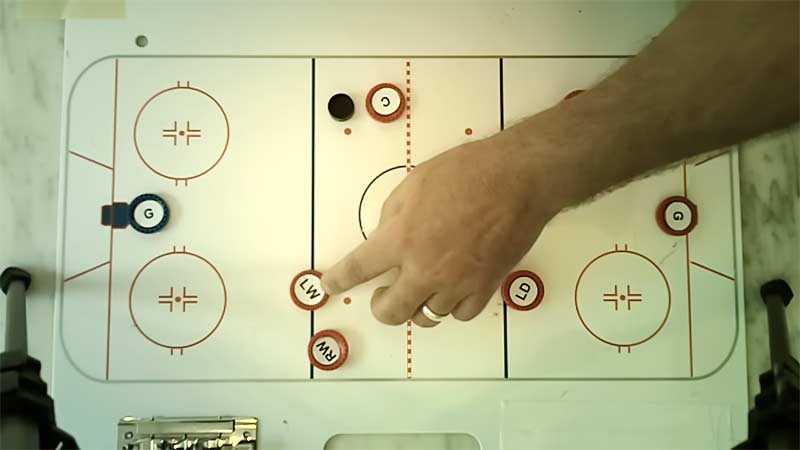Understanding the intricacies of hockey rules can be a game-changer for fans and players alike. One of the most debated and crucial rules in hockey is the offside rule.
This rule, designed to maintain fairness and flow, often becomes a focal point during intense game moments.
Offsides occur when an attacking player enters the offensive zone before the puck does. This can lead to stoppages and even penalties, affecting the game’s rhythm.
With the introduction of the offside review system in the late 2010s, teams can now challenge offside calls, adding another layer of strategy to the game.
However, if the challenge is unsuccessful, the team risks a minor penalty, making it a high-stakes decision.
By grasping how offsides work, you’ll gain a deeper appreciation for the sport’s strategic elements and better understand those nail-biting moments when a game’s outcome hangs in the balance.
Offsides in Hockey Work
In ice hockey, the offside rule is a crucial part of gameplay, designed to keep the game fair and flowing smoothly.
The Basic Rule
An offside in hockey occurs when an attacking player crosses the opponent’s blue line before the puck. The rule ensures fair play by stopping players from camping near the opponent’s goal.
A player is considered offside if both skates are over the blue line before the puck enters the offensive zone. When the referee calls an offside, play stops, and a faceoff occurs outside the offensive zone.
It is important for teams to maintain proper positioning to avoid unnecessary offsides, which can disrupt the flow of the game.
Strategic awareness and effective communication among players are key to staying onside and maintaining offensive pressure.
The Role of the Blue Line
The blue line is crucial in determining offsides. It stretches across the width of the ice, delineating the offensive, defensive, and neutral zones. Players need to position themselves correctly relative to the blue line to avoid an offside call.
If the puck crosses the blue line entirely into the offensive zone while players have not yet entered, they’re safe from an offside infraction. However, if any player precedes the puck across this line, offsides will be called.
Different Zones of a Hockey Rink
In ice hockey, the rink is divided into several zones, each with its own distinct purpose and rules.
Here are the main zones:
Defensive Zone
The defensive zone is where your team defends against the opposing team’s attacks. It starts from the goal line and extends to the blue line nearest your team’s goal.
Players aim to clear the puck out of this zone to prevent scoring opportunities. Effective play in this area requires strong defensive skills, including blocking shots, making clean passes, and strategically positioning yourself.
However, the concept of offsides comes into play when transitioning from the defensive zone to the offensive zone. Offsides occurs if any attacking player enters the offensive zone before the puck.
This rule ensures fair play and maintains the flow of the game. Proper understanding of offsides is crucial for both players and spectators to fully appreciate the strategic elements of hockey.
Neutral Zone
The neutral zone is the area between the two blue lines. This zone acts as a buffer, where neither team has a distinct advantage.
Players often use this space for quick transitions, setting up plays, and maintaining puck control. Your positioning here influences puck movement and can prevent opposing players from entering the attacking zone easily.
Mastery of this zone contributes to smoother shifts in puck control between offense and defense.
Attacking Zone
The attacking zone, also known as the offensive zone, spans from the opponent’s blue line to their goal line. In this zone, your objective is to create scoring opportunities. To avoid an offside, ensure the puck crosses the blue line before you or any teammates do.
The attacking zone also features two faceoff circles, used for restarting play after stoppages like offsides. Positioning and puck control within this zone can significantly impact your team’s scoring chances.
Types of Offsides in Hockey
In hockey, the term “offsides” refers to a violation that occurs when an offensive player crosses the opponent’s blue line into the attacking zone before the puck does.
However, there are different types of offsides that can occur during gameplay:
Delayed Offsides
Delayed offsides occurs when an attacking player enters the offensive zone before the puck, but neither touches the puck nor interacts with an opponent.
The linesman will raise an arm to signal the delayed offside, and attacking players must exit the offensive zone. Once they clear the zone without touching the puck, the offside is nullified, and play continues.
Immediate play stoppage happens only if a player touches the puck while still in the zone. For example, if a player in the offensive zone receives a pass before the puck crosses the blue line, a delayed offside will be called.
Intentional Offsides
Intentional offsides is called when an attacking team deliberately causes an offside. This usually happens when a player shoots the puck into the offensive zone while a teammate is already there.
The referee deems the action deliberate, and a faceoff occurs in the offending team’s defensive zone. This tactic might help a team make a line change if current players need a rest but can’t leave the ice during play.
For example, a player shooting the puck into the zone with teammates ahead of the play risks an intentional offside call.
Offsides Deflections
Offsides deflections are rare but occur when the puck inadvertently bounces off an object or player. If the defending team clears the puck, it hits an official in the neutral zone and returns to the defensive zone; the offside isn’t called.
If the puck deflects off a defending player back into their zone, offsides doesn’t apply, and play continues. For instance, if the puck deflects off a defender’s skate and re-enters their zone, the attacking team can keep playing the puck.
Consequences of an Offside Violation
An offside violation in hockey results in a stoppage of play and various consequences depending on the situation.
Here are the main consequences:
Game Stoppage and Face-Offs
When an offside occurs, the referee stops the play immediately. This prevents any further action from the offensive team.
Right after blowing the whistle, the referee will signal offsides by pointing to where the infraction happened with a chopping motion of the hand.
The game resumes with a face-off in the neutral zone on the same side of the ice where the offsides occurred.
This face-off ensures a fair restart of the game by moving the puck back to a neutral location, impacting the offensive momentum of the team that committed the offside.
The Evolution of Offside Rules
Offside rules in hockey have changed drastically to adapt to the fast-paced nature of the game. In the late 2010s, a new Offside review system emerged, allowing teams to request a review of goals scored during plays suspected to be offside.
If the goal stands, the team requesting the review receives a minor penalty. This system prioritizes accuracy but initially disrupted the game’s flow, leading to mixed reactions from players and fans.
Intentional offsides were addressed to prevent teams from exploiting the rule for tactical advantages. If the attacking team purposely shoots the puck into the offensive zone and a teammate touches it while offside, the play is stopped.
This rule prevents teams from gaining an unfair advantage, particularly during line changes when players are tired and seek a break.
Referees also evaluate offsides deflections, ensuring fair play. If the puck hits an official in the neutral zone and re-enters the defensive zone, it’s called offside.
However, if it deflects off a defending player, the offensive play continues. This distinction reinforces fairness by preventing unintentional game stoppages.
Frequently Asked Questions
What is the purpose of the Offside review system?
The Offside review system aims to ensure precise officiating. It allows for the review of goals to determine if an offside occurred, adding accuracy to the complex and quick-paced nature of hockey.
How does intentional offside work in hockey?
Intentional offside is when a player deliberately enters the attacking zone before the puck to gain an advantage. This results in play stoppage and the subsequent face-off in the offending team’s defensive zone.
Are there penalties for incorrect offside challenges?
Yes, teams are penalized for incorrect offside challenges. If a team challenges an offside and the call on the ice stands, they are typically assessed a minor penalty for delay of game.
How can players avoid being offside in hockey?
Players can avoid being offside by ensuring they do not enter the attacking zone before the puck. Staying aware of their positioning in relation to the blue line and the puck is crucial.
Conclusion
Grasping the offside rule is crucial for appreciating the nuances of hockey. The evolution of these rules, including the offside review system, underscores the sport’s commitment to fairness and precision.
By understanding these dynamics, you can better appreciate the strategic elements and the importance of accurate officiating in maintaining the integrity of the game.
Whether you’re a player, coach, or fan, staying informed about these rules enhances your overall experience and appreciation of hockey.
Hockey continues to evolve, and grasping key aspects like offsides deepens your connection to the game. So, next time you watch a match, you’ll have a more nuanced understanding of what’s unfolding.








James Felix